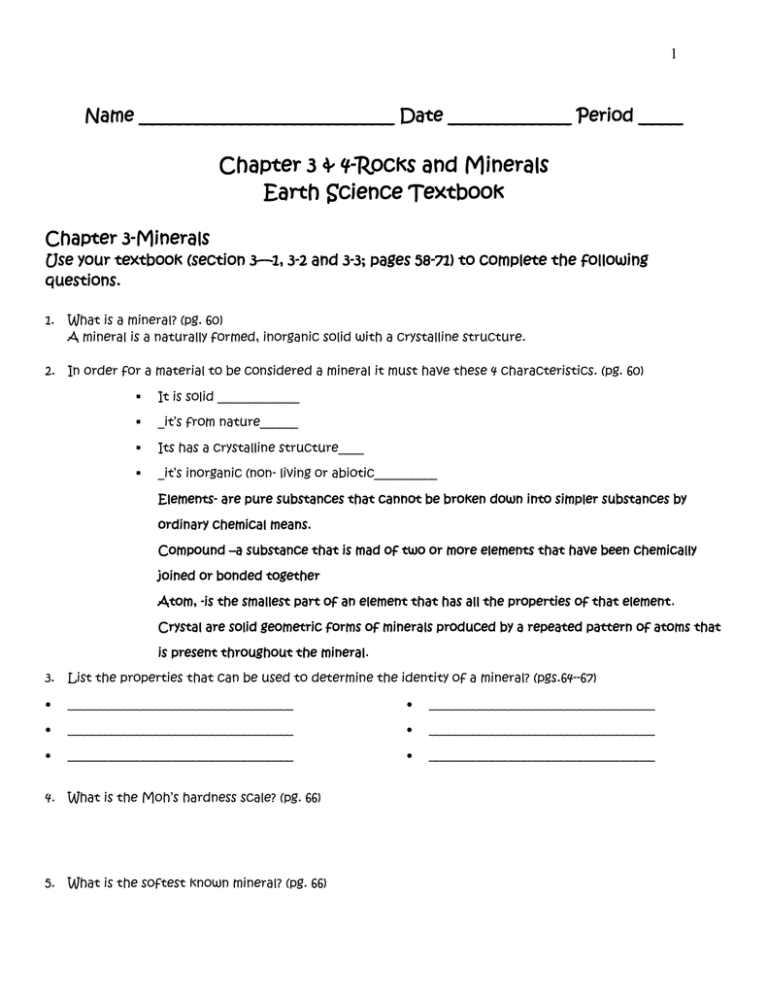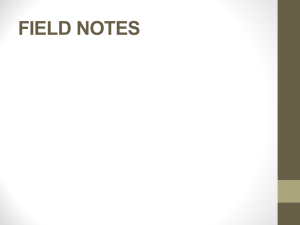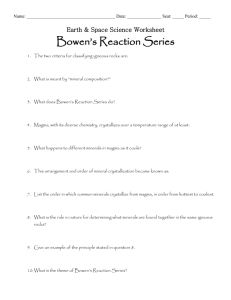Chapter 3 & 4-Rocks and Minerals Earth Science Textbook Chapter
advertisement

1 Name _____________________________ Date ______________ Period _____ Chapter 3 & 4-Rocks and Minerals Earth Science Textbook Chapter 3-Minerals Use your textbook (section 3—1, 3-2 and 3-3; pages 58-71) to complete the following questions. 1. What is a mineral? (pg. 60) A mineral is a naturally formed, inorganic solid with a crystalline structure. 2. In order for a material to be considered a mineral it must have these 4 characteristics. (pg. 60) It is solid _____________ _it’s from nature______ Its has a crystalline structure____ _it’s inorganic (non- living or abiotic__________ Elements- are pure substances that cannot be broken down into simpler substances by ordinary chemical means. Compound –a substance that is mad of two or more elements that have been chemically joined or bonded together Atom, -is the smallest part of an element that has all the properties of that element. Crystal are solid geometric forms of minerals produced by a repeated pattern of atoms that is present throughout the mineral. 3. List the properties that can be used to determine the identity of a mineral? (pgs.64--67) ____________________________________ ____________________________________ ____________________________________ ____________________________________ ____________________________________ ____________________________________ 4. What is the Moh’s hardness scale? (pg. 66) 5. What is the softest known mineral? (pg. 66) 2 6. What is the hardest known mineral? (pg. 60) 7. Why can’t color alone be used to identify most minerals? (pg. 64) 8. What is a streak test? (pg. 65) 9. What is luster? (pg 64) 10. What is the property called of a mineral that breaks easily? What is the characteristic name of this break? (pg. 65) 11. How do minerals form? (pg. 68-69) Chapter 4-Rocks Use your textbook to search chapter 5 in order to complete the following questions. 1. What two characteristics do scientists use to identify/classify a rocks? (pgs.85-86 ) 2. What are the three groups into which geologists classify rocks? (pg 82) 3. _________________________________________________ _________________________________________________ _________________________________________________ What are Igneous Rocks and how are they formed? (pg. 87-89) 3 4. What are Sedimentary Rocks and how are they formed? (pg. 91-94) 5. What are Metamorphic Rocks and how are they formed? (pg. 95-99) 6. What is the difference between extrusive and intrusive rocks? Give an example of each. (pg. 89-90) 7. Why are some igneous rocks dark and others light? (pg. 88-89) 8. What is a coral reef? (pg. 93) 9. Explain how coral reefs form (pgs. 93) 10. What process gradually changes rocks from one form to another? Pg, 95-97) 4 11. Use your textbook to draw and label a picture of the Rock Cycle below. (page 84) 12. Begin with a grain of sand on a beach. Describe what happens as you follow the grain of sand through the rock cycle, until it returns to the beach as a grain of sand! (list and explain each of the steps of the rock cycle in your answer) (page 83) 5







